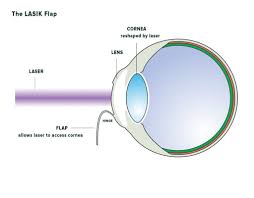Table of Contents
ToggleOccasionally, Lasik patients report experiencing visual hallucinations as a temporary side effect, often stemming from the brain’s adjustment to changes in vision or due to corneal irregularities.
These phenomena, while unsettling, are typically not harmful and diminish as the eyes heal from surgery.
Lasik (laser-assisted in situ keratomileusis) has revolutionised the way people correct refractive errors like nearsightedness, farsightedness, and astigmatism. While the procedure boasts a high success rate, some patients experience unexpected effects during their recovery, including visual hallucinations. These effects can range from seeing halos and starbursts to perceiving phantom objects or light patterns. This blog dives into the potential causes and mechanisms behind Lasik-induced visual hallucinations, offering insights to help patients understand and manage these occurrences.
What Are Visual Hallucinations After Lasik?
Visual hallucinations post-Lasik aren’t akin to the hallucinations associated with mental health disorders. Instead, they refer to unusual visual phenomena such as:
- Halos around lights
- Starbursts emanating from bright light sources
- Apparent movement of light patterns
- Difficulty distinguishing objects in dim lighting
- Ghost images or double vision
These visual effects are generally non-threatening and often resolve on their own as the eyes heal. However, understanding the reasons they occur is crucial to answering concerns and improving outcomes.
Why Do Some Lasik Patients Experience These Phenomena?
1. Corneal Healing and Edema
One key cause of visual inconsistencies following Lasik is the healing process of the cornea. During Lasik, a thin flap of corneal tissue is created and reshaped using a laser to correct vision. This manipulation can cause mild inflammation or corneal edema, which temporarily affects the way light enters the eye.
- Swelling may alter the cornea’s curvature slightly, leading to distorted or scattered light perception.
- Objects may appear blurry or surrounded by halos as your eyes recover from surgery.
2. Changes in Optics and Neural Adaptation
Vision is a partnership between the eye and the brain. Lasik reshapes the cornea to modify how light is refracted onto the retina, and this heightened demand for the brain to adapt can contribute to temporary hallucinations:
- Pre-surgery, the brain becomes accustomed to interpreting distorted or out-of-focus signals due to refractive errors. However, after Lasik, clearer visual input can be perceived as unfamiliar, requiring the brain to recalibrate how it processes this information.
- This recalibration can sometimes lead to visual disturbances such as “phantom lights” or difficulty adjusting to subtle lighting changes.
3. Night Vision Challenges and Halo Formation Laterally
One of the most common issues patients describe are halos and starbursts, especially when driving at night. These phenomena are often attributed to:
- Low light conditions: Under dim lighting, the pupil dilates to allow more light in. However, a widened pupil can extend beyond the treated zone of the cornea, causing light to scatter irregularly.
- Peripheral light scatter: The contrast between treated and untreated corneal zones can amplify scatter effects, making halos more pronounced around car headlights or streetlights.
4. Higher-Order Aberrations
Lasik may unintentionally introduce or exaggerate higher-order aberrations (HOAs), which refer to complex optical imperfections. Common HOAs include:
- Spherical Aberration: Occurs when light rays entering at the edges of the cornea don’t focus correctly on the retina.
- Coma: Causes point sources of light, such as streetlights, to look like smears or streaks.
- Patients with pre-existing corneal irregularities or large pupils may be more prone to experiencing these effects.
5. Dry Eye Post-Lasik: A Contributing Factor
Many Lasik patients experience temporary dry eye syndrome, which arises when the procedure disrupts tear production or surface nerves in the cornea.
- Dry eyes fail to distribute tears properly across the surface, leading to blurriness and light sensitivity.
- These symptoms can magnify visual disturbances, especially in environments that are dry or air-conditioned.
6. Underlying Neurological or Psychosensory Factors
Though rare, some visual hallucinations after Lasik may be linked to:
- Pre-existing ocular conditions like retinal disorders or optic nerve issues, which exacerbate visual disturbances.
- Psychosensory factors, wherein post-operative anxiety or hyper-awareness of visual changes leads patients to perceive symptoms more acutely.
How Long Do These Hallucinations Last?
Most visual disturbances following Lasik resolve naturally as the cornea heals and the brain adjusts to post-surgical vision:
- Short-term effects like halos and sensitivity typically last a few weeks to months.
- For patients experiencing longer-lasting issues, advanced treatments or touch-ups can help improve visual clarity.
If symptoms persist beyond the typical recovery period or significantly disrupt daily activities, patients should consult their surgeon or ophthalmologist for evaluation.
Managing Visual Hallucinations Post-Surgery
1. Follow Your Post-Lasik Care Instructions
Adhering to all post-operative care guidelines can significantly aid recovery and minimise complications:
- Use prescribed antibiotic and anti-inflammatory eye drops.
- Wear protective goggles during sleep to prevent corneal irritation.
- Avoid rubbing your eyes during the healing process.
2. Address Dry Eye Promptly
Combat dry eye symptoms by:
- Using preservative-free artificial tears to keep your eyes hydrated.
- Blinking frequently, especially when using digital devices.
3. Seek Reassurance from Your Doctor
If you’re concerned about persistent visual distortions, reporting them to your surgeon promptly is essential. Modern Lasik practices utilise customised wavefront-guided technology to minimise HOAs, reducing the likelihood of long-term disturbances.
4. Advanced Treatments for Persistent Disturbances
For rare cases where symptoms remain unresolved, additional interventions may include:
- Enhancement procedures to fine-tune refractive outcomes.
- Specialty contact lenses (like scleral lenses) to correct aberrations.
- Punctal plugs or Restasis for chronic dry eye management.
The Role of Pre-Surgical Assessment in Avoiding Complications
Comprehensive pre-operative evaluations play a critical role in lowering the risk of visual hallucinations post-Lasik. Top procedures carefully assess factors like:
- Pupil size
- Corneal thickness and topography
- Tear production levels
Patients with specific risk factors, such as large pupils or severe refractive errors, may be guided toward customised Lasik alternatives or alternative procedures like PRK (photorefractive keratectomy).
Empowering Patients with Knowledge
Understanding why visual hallucinations occur during the Lasik recovery process can reassure patients that these experiences are generally temporary. By being proactive about post-operative care and having open communication with your surgeon, you can manage and eventually diminish these rare occurrences.
Lasik is a life-changing procedure for millions around the globe, with long-term success and satisfaction rates exceeding 95%. If you’re considering Lasik or are navigating recovery, remember that temporary visual disturbances are merely stepping stones to the ultimate goal of clear, hassle-free vision.
Still Have Questions?
If you’d like to learn more about managing Lasik side effects or want to explore whether you’re a good candidate for this procedure, schedule a consultation with a qualified ophthalmologist today.













